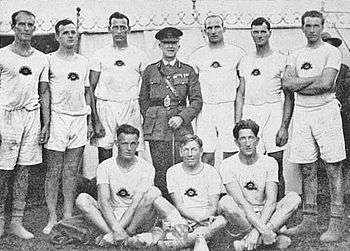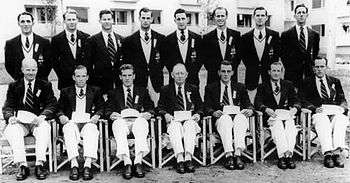Leichhardt Rowing Club
Leichhardt Rowing Club formed in 1886 is one of the oldest rowing clubs in Sydney, Australia. It has occupied its current site on Port Jackson's, Iron Cove at Leichhardt since 1886. Leichhardt is an all-level competitive and recreational rowing club, with a long history of supporting women's rowing. The club has enjoyed a rebirth in the new millennium partly due to the success of its Masters, Corporate Challenge and learn-to-row programs.
| Location | Leichhardt, Sydney, Australia |
|---|---|
| Home water | Iron Cove, Sydney Harbour |
| Founded | 29 May 1886 |
| Affiliations | NSW Rowing Association |
| Website | www.lrc.com.au |
History
S.G Davison, the Mayor of Leichhardt presided over a public meeting at the Leichhardt Council Chambers on 29 May 1886 which was called for the purpose of forming a rowing club. Permission was obtained from the Crown for the Leichhardt Park Trustees to permit the use of water frontage for baths and rowing club sheds through the efforts of Solomon Hyam MLA. After a boatshed was built, Sir Henry Parkes, Premier of New South Wales formally opened the new club at a ceremony on 24 September 1887 before the largest group of people ever assembled on Leichhardt Park.[1] The club was established free from the pressure of the amateur principle in place at Sydney and Mercantile. It was for both "manual labourers" and "brain toilers" and Parkes, who described rowing as "a healthy, beautiful and manly exercise", expressed his approval of the club's democratic principle regarding membership.[2]
The club took delivery of its first boat – a single skiff – in late 1887. Life membership subscriptions paid by some of the foundation directors were used to fund a few further skiff purchases. Leichhardt was admitted to the New South Wales Rowing Association in March 1893. A severe storm fully destroyed the club and its fleet of boats in 1897 but rebuilding and replacement was fully complete by 1900.[1] The club's initial racing colours were buff and blue but by 1902 club equipment was being painted in red and blue, the club's livery ever since.
Henry Hauenstein was the club's first selected Olympic competitor, rowing in the men's eight at Stockholm 1912. He had regularly appeared in the New South Wales state eight since 1907.[3] Over 100 club members left to see active service in World War I and a number fell. After the armistice Hauenstein and fellow club-member Tom McGill rowed (along with Middleton of the Sydney Rowing Club) in the victorious AIF crew at Royal Peace Regatta who won the cup for eight-oared boats presented by King George V. In time, the King's Cup, became the trophy presented to the winning men's eight at the annual Australian Rowing Championships.
At the commencement of World War II the club had 40 active members. By the war's end 90 club members had served in the forces. The Australian Military Forces occupied the park, foreshore and clubhouse from 1943 and the boats were rehoused at the neighbouring Haberfield Rowing Club.[4]
Leichhardt Rowing Club began co-operating with nearby ladies rowing clubs from about 1910. Women began rowing for the club in the 1950s. In 1976 the club constitution was changed to admit women as constitutional members.
The 1950s was a golden era for the club. Leichhardt won the Sydney premiership four times, including a hat trick, was runner-up four other times and third in the other two years. Four club men were selected for Olympic representation at Helsinki 1952 and five for Melbourne 1956.
Club Presidents
- Fred Walsh was the club's first president.
- FG Baker was president during World War II and instrumental in the new clubhouse built in 1940.
- Tim Clare was the club's president till 2012.
- Charles Bartlett, lightweight world champion 1980–81 is the club's president since 2012.


Members
Notable past members include:
- W Lambert was Leichhardt's first state title holder winning the NSW Sculling Championship in 1894,1895 & 1899. He was later a Mayor of Leichhardt.
- Lt. Tom McGill was a member of the victorious AIF men's eight at the 1919 Royal Peace Regatta held following the end of World War I. He rowed in NSW King's Cup crews from 1920–22.
- H.V. Evatt the Australian jurist, politician and writer who was leader of the Australian Labor Party from 1951 to 1960.
Olympic representative members include:[5]
- Lt. Henry Hauenstein, Olympic competitor Stockholm 1912 and member of the victorious AIF men's eight at the 1919 Royal Peace Regatta.
- Arthur Bull, national sculling champion 1922 & 1923 and Olympic competitor Paris 1924.
- Mervyn Finlay, Nimrod Greenwood, Geoff Williamson and David Anderson Olympic bronze medallists Helsinki 1952.
- Stuart MacKenzie Olympic silver medalist Melbourne1956.
- Geoff Williamson, David Anderson, Peter Evatt and John Harrison Olympic competitors Melbourne1956.
- Peter Dickson Olympic silver medallist Mexico City 1968.
- Gillian Campbell competitor at Barcelona 1992.
References
Footnotes
- Kavanagh, Merle (1986–2006). Rowing on with Leichhardt (previously published as ‘On These Bright Waters: A Centennial History of Leichhardt Rowing Club 1886–1986’. Leichhardt Rowing Club. ISBN 9780646432823. OCLC 225172802. Retrieved 5 October 2011.
- http://www.rowinghistory-aus.info/club-histories/sydney/03-1.php Early club histories
- http://www.rowinghistory-aus.info/interstate-championships/1907.php#M8 Archived 28 July 2018 at the Wayback Machine Guerin-Foster King's Cup History
- http://www.rowinghistory-aus.info/club-histories/leichhardt/10.php Guerin-Foster history
- http://www.rowinghistory-aus.info/club-histories/leichhardt/Appendix08.php Leichhardt History
Bibliography
- Kavanagh, Merle (1986) On These Bright Waters, A Centennial History of Leichhardt Rowing Club 1886–1986 (reproduced on Guerin-Foster)
- May, Alan (1970) Centennial History of the Sydney Rowing Club, Sydney Rowing Club (reproduced on Guerin-Foster)